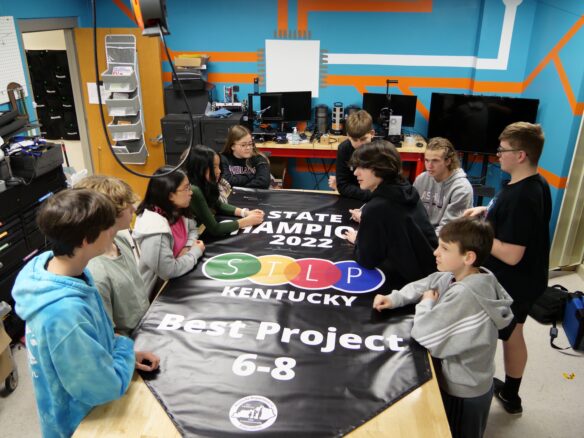
Ashland Middle School (Ashland Independent) students were awarded Best 6-8 Project at the 2022 Kentucky STLP State Championship on April 20. The team developed an in-home hub to help make life easier for individuals with memory loss and ease the burden on their families by providing reminders, facilitating communication and providing a greater sense of security. Photo courtesy of Ashland Middle School.
Caroline Yates, an 8th grade student at Ashland Middle School (Ashland Independent), wanted to use her student technology leadership program (STLP) project to explore an issue close to her family – Alzheimer’s.
“[It affects] my grandma – so it affects my mom and my grandpa,” explained Yates.
Yates was a part of a 15-person student team that worked on Ashland Middle School’s (AMS’) “Helping Those in Need” project, which took home Best Grade 6-8 Project at the STLP State Championship on April 20.
Fifteen students worked on the project at various stages. They were Caroline Yates, Reagan Hayes, Caity Pierce, Ryder Phillips, Caleb Conway, Luke Corliss, Cameron Davis, Kahlil Ealey, Caden Ferguson, Jonah Francis, Zac Johnson, Rilee Bohanon, Ryder Prickett, Lesly Reyes and Carter Williams. For many of the students, it was their first time to work on an STLP project.
STLP Projects address real-life concerns, issues or challenges that students identify. Successful projects present their elevator pitch focusing on the STLP Tech Standards: empowered learner, digital citizenship, knowledge constructor, innovative designer, computational thinker, creative communicator and global collaborator.
The AMS students began by brainstorming projects that interested them or topics with personal connections.
“We made a list of all kinds of ideas and this was the one we all liked the most,” said Phillips.
Hayes’ dad is a medical doctor so the team consulted him on what a person with Alzheimer’s would find helpful. They eventually landed on the idea of creating an in-home hub to help make life easier for individuals with memory loss and ease the burden on their families by providing reminders, facilitating communication and providing a greater sense of security.
The interactive box contains two kits from Google that the students built following the provided instructions and an online tutorial. The first is an AIY Vision Kit, used to build an intelligent camera that can see and recognize objects using machine learning, and the second kit is an AIY Voice Kit used to build a natural language processor that allows the person interacting with the box to ask questions and issue voice commands. Both fit inside their own little cardboard cube, powered by Raspberry Pi, a credit card-sized computer.
After the design team worked on the box, the students felt the first design was “obnoxious” with its bright orange exterior, so they went back to the drawing board. The submitted design is their second prototype.
“The first one we made, we had a lot of things that we wanted to do, but once we actually tried it, it didn’t work. We had to go back and redesign it,” said Phillips.
The students also presented their project in the Samsung Solve for Tomorrow contest. AMS was named one of 100 state winners and received $6,500 along with Samsung products and classroom resources. Over the past five years, AMS has been a state finalist four times, a national finalist twice and the national champion in 2017-2018.
The students agreed that STLP and AMS’ STEM program has given them the chance to practice lifelong skills such as collaborating with others, creative problem-solving and presentation skills.
“[STLP] really helped me get out there and speak to other people about our project,” said Ferguson.
“It was very interesting to learn about how to put it all together and to incorporate all of the different types of technology and innovation to solve a problem,” said Yates. “That really helped us gain new perspectives on problem-solving.”
AMS STLP Coach Mark Harmon said that words cannot describe how proud he is of the students and their two wins.
“At the beginning of the project, they started coming up with these big ideas … it was one of those things where [I said] ‘Eh, you can attempt it, but I doubt we get there.’ However, they have gone above and beyond all of those expectations, and they have really impressed me with this,” said Harmon. “We do a lot of STEM, we do a lot of technology. It gives them an outlet to apply their learning into something that is real and personable and tangible.”
The students and their teacher will head to New Orleans, La. in June to present their project at the ISTELive educational technology conference.



Leave A Comment